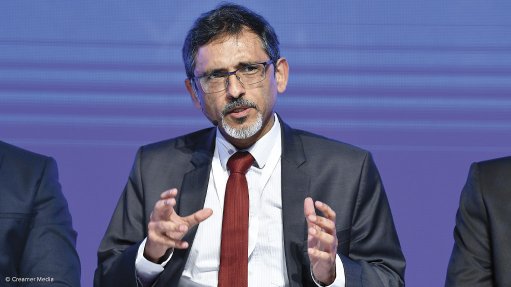EIUG scrutinises Eskom application for recovery of costs
The Energy Intensive User Group (EIUG) of Southern Africa on Tuesday submitted its comments to the National Energy Regulator of South Africa (Nersa) regarding State-owned power utility Eskom’s regulatory clearing account (RCA) applications for 2014/15 to 2016/17 and says Nersa should allow only R40-billion of the R65-billion clawback requested by Eskom.
This follows after Nersa last week moved forward public hearings into Eskom’s RCA applications. Public hearings will start on April 16 and continue until May 14. Nersa’s electricity subcommittee will on June 14 consider draft reasons for decision, with Nersa to announce a decision on the RCA applications on June 21.
EIUG CEO Xolani Mbanga, speaking on behalf of energy intensive consumers that account for 40% of electricity use in South Africa, said Eskom has not shown any real intent to restructure the business to properly address its liquidity challenges.
“The marginal adjustments and cost savings have not and will not save Eskom. Eskom continues to hide behind the regulations and look to its customer base to bail it out. Unless forced to change, it will continue to operate in the same way,” he pointed out.
The EIUG further stated that the irony of Eskom’s application is that it claims sluggish growth in electricity demand, which was at least partly owing to the unavailability of electricity supply, load-shedding, load curtailment and higher electricity prices of recent years.
“Customers were required to reduce their electricity consumption by 10% or face load-shedding. The result of their compliance is penalisation for not consuming electricity, which Eskom could not produce anyway,” explained Mbanga.
He added that the burden of such inefficiencies cannot be borne by the customer base.
CASE IN POINT
The EIUG concedes that the recovery of costs in the RCA applications should be sufficient to maintain Eskom’s liquidity and avoid a default, but no larger, so that it is forced to make a fundamental change in its management and operations.
Moreover, the industry body believes Nersa is best positioned to find the balance between what should be allowed to maintain liquidity and what can be absorbed by the market without seriously impeding economic growth or causing job losses.
The EIUG requested Nersa to verify the claims made by Eskom for the over-expenditure on primary energy, international purchases, independent power producer costs and to disallow all other inefficiently and imprudently incurred costs.
Mbanga highlighted that the EIUG’s analysis shows that aspects within Eskom’s control have led to the requirement for higher tariffs.
“These include Eskom’s poor and outdated planning and inefficient management; the fact that Eskom appears to have moved money around – against the Nersa-approved Multi Year Price Determination 3 (MYPD3) plans – to other areas without Nersa’s approval; a capital expenditure (capex) overspend of about R40.9-billion; and 20% overspend on coal costs owing to inefficiencies.”
The industry body’s detailed analysis shows that there are areas of the RCA applications, for coal purchasing and handling and water use and treatment, where costs should and could have been reduced in line with the reduced electricity demand, but were not.
Further, it is not within the RCA parameters for Eskom to claim capex over-expenditure in the RCA applications.
“There is clearly little or no conformance by Eskom to the MYPD3 regulatory decision in most of the expenditure items. The MYPD was meant to provide a price-path that would enable customers, investors and other stakeholders to plan with a certain level of certainty with respect to future electricity prices,” Mbanga noted.
However, the divergence between the forecast sales volumes by Eskom and actual sales, coupled with its inability to maintain and operate the existing generation fleet at optimal levels have resulted in RCA applications that significantly alter the price path predicted by the MYPD3, says the EIUG.
Comments
Press Office
Announcements
What's On
Subscribe to improve your user experience...
Option 1 (equivalent of R125 a month):
Receive a weekly copy of Creamer Media's Engineering News & Mining Weekly magazine
(print copy for those in South Africa and e-magazine for those outside of South Africa)
Receive daily email newsletters
Access to full search results
Access archive of magazine back copies
Access to Projects in Progress
Access to ONE Research Report of your choice in PDF format
Option 2 (equivalent of R375 a month):
All benefits from Option 1
PLUS
Access to Creamer Media's Research Channel Africa for ALL Research Reports, in PDF format, on various industrial and mining sectors
including Electricity; Water; Energy Transition; Hydrogen; Roads, Rail and Ports; Coal; Gold; Platinum; Battery Metals; etc.
Already a subscriber?
Forgotten your password?
Receive weekly copy of Creamer Media's Engineering News & Mining Weekly magazine (print copy for those in South Africa and e-magazine for those outside of South Africa)
➕
Recieve daily email newsletters
➕
Access to full search results
➕
Access archive of magazine back copies
➕
Access to Projects in Progress
➕
Access to ONE Research Report of your choice in PDF format
RESEARCH CHANNEL AFRICA
R4500 (equivalent of R375 a month)
SUBSCRIBEAll benefits from Option 1
➕
Access to Creamer Media's Research Channel Africa for ALL Research Reports on various industrial and mining sectors, in PDF format, including on:
Electricity
➕
Water
➕
Energy Transition
➕
Hydrogen
➕
Roads, Rail and Ports
➕
Coal
➕
Gold
➕
Platinum
➕
Battery Metals
➕
etc.
Receive all benefits from Option 1 or Option 2 delivered to numerous people at your company
➕
Multiple User names and Passwords for simultaneous log-ins
➕
Intranet integration access to all in your organisation


















